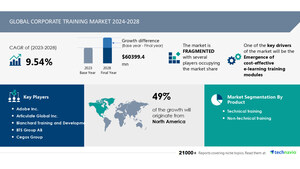NEW YORK, March 15, 2024 /PRNewswire/ -- The personal consumer electronics market size is forecast to increase by USD 92.66 billion from 2022 to 2027. The market is estimated to grow at a CAGR of 5.04%, according to a recent market study by Technavio. In a thriving global market, vendors are driving growth through frequent product launches and a relentless focus on innovation. Notably, Samsung Electronics Co. Ltd. unveiled the Bespoke Infinite Line Refrigerator in January 2023, offering refrigerator, freezer, or wine cellar models. This premium built-in refrigerator boasts a timeless modular design, seamlessly integrating into diverse interiors. Similarly, Xiaomi Communications Company Ltd., operating under its Redmi brand, introduced the 75-inch smart TV model in December 2021 in China, subsequently launching in India in Q1 2022. Such continuous innovation aims to captivate consumer interest, bolster sales, and foster market expansion throughout the forecasted period.
Charts & data tables about market and segment sizes for a historic period of five (2017-2021) years have been covered in this report. Download The Sample Report
Technavio has extensively analyzed 15 major vendors, including Apple Inc., Bajaj Electricals Ltd., Dell Technologies Inc., Electrolux AB, Fujitsu Ltd., Havells India Ltd., Hisense International Co. Ltd., Hitachi Ltd., HP Inc., Huawei Technologies Co. Ltd., Koninklijke Philips NV, Lenovo Group Ltd., LG Corp., Micromax Informatics Ltd., Panasonic Holdings Corp., Samsung Electronics Co. Ltd., Sony Group Corp., Toshiba Corp., Whirlpool Corp., and Xiaomi Communications Co. Ltd.
Get a holistic overview of the personal consumer electronics market from industry experts to evaluate and develop growth strategies. Download the Sample
Key Benefits of Purchasing this Report
- The report offers information on the criticality of vendor inputs, including R&D, CAPEX, and technology.
- It also provides detailed analyses of the market's competitive landscape and vendors' product offerings.
- The report also provides a qualitative and quantitative analysis of vendors to help clients understand the wider business environment as well as the strengths and weaknesses of key market players. Data is qualitatively analyzed to categorize vendors as pure play, category-focused, industry-focused, and diversified; it is quantitatively analyzed to categorize vendors as dominant, leading, strong, tentative, and weak.
Expand operations in the future - To get requisite details, ask for a custom report.
Segmentation Analysis
The personal consumer electronics market report extensively covers market segmentation by product type (smartphones, tablets laptops and notebooks, portable devices, digital cameras, and others), distribution channel (offline and online), and geography (APAC, Europe, North America, South America, and Middle East and Africa).
- The market share growth by the smartphones segment is significant for the market growth during the forecast period. The global consumer electronic segment comprises the market for smartphones with advanced computing and connectivity capabilities in addition to basic voice communication. Some of the key features which smartphones offer include internet access, multimedia capabilities, and a wide range of applications, all of which have become a vital part of daily modern life. There has been significant growth in the smartphone market due to advancements in technology, rising consumer demand, and an increased need for mobile services. Hence, such factors are expected to drive market growth during the forecast period.
To get detailed insights about inclusions and exclusions, buy the report
- The rapid growth of the e-commerce industry is a key trend in the personal consumer electronics market during the forecast period.
- Fluctuation in prices of raw materials and operational costs is a significant challenge hindering the personal consumer electronics market growth during the forecast period.
Analyst Review
The global personal consumer electronics market is witnessing unprecedented growth, driven by factors such as smartphone proliferation, technological advancements, and the widespread adoption of 3G and 4G technologies. In the United States, the consumer electronics landscape is evolving rapidly, with continuous technological developments shaping the market. Smart devices like desktop PCs, phablets, and IoT gadgets are becoming increasingly prevalent, catering to diverse consumer needs.
One notable trend is the rise of fitness bracelets, reflecting the growing emphasis on health and wellness among consumers. Moreover, the availability of these devices is supported by rising consumer disposable income, fueling demand in the bring-your-own-device (BYOD) market. This trend extends to traditional computing devices such as desktops and laptops/notebooks, along with peripherals like hard disk drives and e-readers.
Operating systems like Android and Windows dominate the market, offering consumers a wide range of choices in terms of device compatibility and user experience. In the Asia-Pacific region, sales channels play a crucial role, with sales representatives offering personalized customer service to enhance the shopping experience and foster customer loyalty.
Online shopping platforms have revolutionized the way consumers purchase personal electronics, providing convenience and accessibility. Internet connectivity, facilitated by mobile devices, ensures seamless access to e-commerce platforms, where consumers can benefit from doorstep delivery and hassle-free return policies.
Innovation remains at the forefront of the personal consumer electronics market, driving the introduction of new products such as tablets and laptops that cater to evolving consumer preferences. The competition between iOS and Android ecosystems continues to shape consumer choices, both online and offline.
Offline retail stores also play a significant role, offering consumers the opportunity to experience products firsthand before making a purchase. However, online platforms provide unparalleled convenience, allowing consumers to compare prices and read reviews from the comfort of their homes.
In conclusion, the personal consumer electronics market is characterized by smartphone proliferation, technological advancements, and a growing array of smart devices. With increasing consumer disposable income and the BYOD market on the rise, innovation and convenience are driving forces behind consumer preferences, both online and offline.
Market Overview
The global consumer electronics market is experiencing a transformative phase driven by smartphone proliferation and continuous technological advancements. With the widespread adoption of 3G and 4G technologies, connectivity has become seamless, powering the rise of smart devices and IoT integration. In the U.S. consumer electronics market, technological developments are shaping consumer preferences towards versatile gadgets like desktop PCs, phablets, and IoT-enabled devices. Phablets, a hybrid of smartphones and tablets, are gaining traction due to their larger displays and enhanced functionalities. As technology evolves, the personal consumer electronics market continues to expand, offering consumers a diverse range of innovative products tailored to their ever-changing needs and preferences.
Related Reports:
The microwave radio market size is estimated to grow at a CAGR of 17.93% between 2022 and 2027. The market size is forecast to increase by USD 20,867.98 million. This microwave radio market report extensively covers market segmentation by type (hybrid microwave radio, packet microwave radio, and TDM microwave radio), application (communication, power utilities, and others), and geography (APAC, North America, Europe, Middle East and Africa, and South America). The increasing demand for point-to-point communication networks is driving market growth.
The smart home cameras market size is estimated to grow at a CAGR of 14.88% between 2022 and 2027. The market size is forecast to increase by USD 3,991.67 million. This smart home cameras market report extensively covers market segmentation by connectivity (wire-free smart home cameras and wired smart home cameras), distribution channel (offline and online), and geography (North America, APAC, Europe, South America, and the Middle East and Africa). One of the key factors driving the smart home cameras market growth is the rising adoption of smart home systems.
Table of Contents
1 Executive Summary
2 Landscape
3 Sizing
4 Historic Size
5 Five Forces Analysis
6 Segmentations
7 Customer Landscape
8 Geographic Landscape
9 Drivers, Challenges, and Trends
10 Vendor Landscape
11 Vendor Analysis
12 Appendix
About US
Technavio is a leading global technology research and advisory company. Their research and analysis focus on emerging market trends and provide actionable insights to help businesses identify market opportunities and develop effective strategies to optimize their market positions. With over 500 specialized analysts, Technavio's report library consists of more than 17,000 reports and counting, covering 800 technologies, spanning 50 countries. Their client base consists of enterprises of all sizes, including more than 100 Fortune 500 companies. This growing client base relies on Technavio's comprehensive coverage, extensive research, and actionable market insights to identify opportunities in existing and potential markets and assess their competitive positions within changing market scenarios.
Contact
Technavio Research
Jesse Maida
Media & Marketing Executive
US: +1 844 364 1100
UK: +44 203 893 3200
Email: [email protected]
Website: www.technavio.com
SOURCE Technavio

WANT YOUR COMPANY'S NEWS FEATURED ON PRNEWSWIRE.COM?
Newsrooms &
Influencers
Digital Media
Outlets
Journalists
Opted In





Share this article